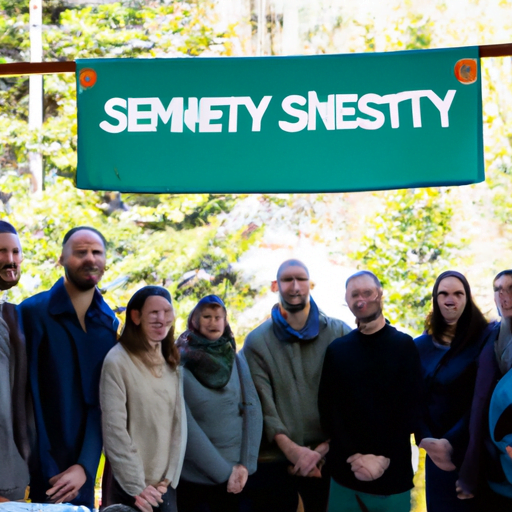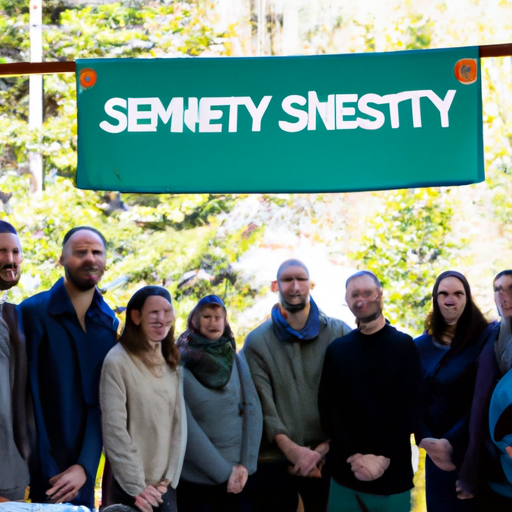Have you ever wondered what it would be like to live off the grid, completely independent from the traditional power grid and outside resources? Well, there is a concept called self-sustaining community that dives into this very idea. It’s fascinating to think about creating a community where all the necessary resources are generated and managed within its own boundaries. In this article, we’ll explore the concept of a self-sustaining community and delve into the various aspects that make it unique and environmentally friendly.
So, what exactly is a self-sustaining community? It’s a community that aims to fulfill all its needs and sustain itself without reliance on external resources. This means generating its own power through renewable energy sources like solar panels or wind turbines, growing its own food through sustainable farming practices, and managing its own waste and water systems. Essentially, the goal is to minimize the community’s impact on the environment while maximizing its self-sufficiency.
Living in a self-sustaining community offers numerous benefits. Not only does it provide a sense of independence and resilience, but it also promotes sustainability and environmental consciousness. As members of such a community, you have the opportunity to actively participate in the production and management of resources, fostering a sense of connection with the environment and your fellow community members. In the upcoming article, we’ll explore different examples of self-sustaining communities around the world and discuss the challenges they face, as well as the potential for this concept to shape the future of sustainable living. Stay tuned to learn more!

Exploring the Concept of a Self-Sustaining Community
Off grid living has gained significant attention in recent years as people become more aware of the environmental and social challenges we face. Many individuals and communities are seeking alternative ways of living that are sustainable, self-reliant, and promote a harmonious relationship with nature. One such alternative is the concept of a self-sustaining community, where individuals come together to create a self-reliant and resilient society. In this article, we will delve into the definition, key characteristics, benefits, and examples of self-sustaining communities. We will also explore the various aspects involved in building and maintaining such a community.
Definition of a Self-Sustaining Community
A self-sustaining community, also known as an eco-village or intentional community, is a group of individuals who work together to create a sustainable and self-reliant society. These communities aim to minimize their ecological footprint by integrating social, economic, and environmental practices that promote self-sufficiency and resilience. The members of a self-sustaining community often share common values and goals, such as living in harmony with nature, practicing sustainable agriculture, and fostering a strong sense of community.
Key Characteristics of a Self-Sustaining Community
Self-sustaining communities have several key characteristics that set them apart from traditional urban or suburban neighborhoods. These include:
Sustainability: Self-sustaining communities prioritize sustainable living practices, such as renewable energy generation, waste management, and water conservation. They aim to minimize their impact on the environment and work towards long-term ecological balance.
Self-reliance: Members of a self-sustaining community strive to meet their basic needs without relying heavily on external resources. They prioritize creating alternative systems for energy, food, water, and housing to reduce dependence on mainstream infrastructure.
Collaboration and Cooperation: Self-sustaining communities emphasize collaboration and cooperation among their members. They work together to develop and maintain infrastructure, share resources, and collectively make decisions that benefit the entire community.
Shared Values and Goals: Members of a self-sustaining community typically share common values and goals. These may include a commitment to environmental stewardship, social justice, and personal growth. Shared values foster a strong sense of community and enhance the sense of belonging among the members.
Benefits of a Self-Sustaining Community
Self-sustaining communities offer several benefits to their members and the wider society. These include:
Environmental Benefits: By reducing reliance on fossil fuels, minimizing waste generation, and practicing sustainable agriculture, self-sustaining communities contribute to a healthier and more sustainable environment. They serve as models for ecological conservation and provide alternative solutions to mitigate climate change.
Resilience and Self-Sufficiency: Self-sustaining communities are designed to be resilient in the face of external crises and disruptions. By producing their own food, generating renewable energy, and implementing water management systems, these communities are better prepared to handle emergencies and adapt to changing circumstances.
Enhanced Quality of Life: Living in a self-sustaining community can improve the quality of life for its members. The strong sense of community, shared responsibilities, and opportunities for personal growth and skill development create an enriching and fulfilling lifestyle.
Social and Economic Benefits: Self-sustaining communities often foster local economies, supporting small businesses and local producers. They also promote social cohesion, cultural diversity, and social justice by creating inclusive and equitable living environments.
Examples of Self-Sustaining Communities
Several self-sustaining communities around the world serve as inspiration and examples of successful sustainable living. Here are a few notable examples:
Findhorn Ecovillage (Scotland): Founded in the 1960s, Findhorn Ecovillage is known for its innovative ecological practices, organic farming, and sustainable development initiatives. It has become a premier center for sustainable education and spiritual exploration.
Solviva Green Valley (India): Located in Auroville, India, Solviva Green Valley is a self-sustaining community focused on permaculture, organic farming, renewable energy, and water conservation. It serves as a living example of sustainable living practices in a diverse cultural context.
Earthaven Ecovillage (United States): Situated in the mountains of North Carolina, Earthaven Ecovillage is dedicated to regenerative living practices and reconnecting with nature. It showcases sustainable construction methods, renewable energy, and organic agriculture.
These communities demonstrate the potential for designing and implementing self-sustaining models that foster ecological, social, and economic well-being.
Developing a Self-Sustaining Community
Building a self-sustaining community involves careful planning, design, and implementation of various aspects. Here are some key considerations:
Identifying Suitable Land for a Self-Sustaining Community
The first step in developing a self-sustaining community is finding suitable land that can support the needs of the community. Factors to consider include access to water sources, soil quality for agriculture, proximity to urban areas for potential networking, and adherence to local zoning regulations.
Designing Infrastructure and Utilities
Once the land is secured, designing and constructing infrastructure and utilities becomes crucial. This includes developing systems for energy generation, waste management, water supply and treatment, transportation, and communication. Attention must be given to creating efficient, eco-friendly, and resilient systems that meet the needs of the community.
Implementing Sustainable Farming Practices
Self-sustaining communities prioritize sustainable agriculture and food production. This involves implementing organic farming techniques, permaculture systems, and community gardens. By growing their own food, communities can reduce their dependence on external sources and ensure food security.
Building Sustainable Housing in a Self-Sustaining Community
Housing plays a vital role in self-sustaining communities. Here are some considerations when it comes to building sustainable housing:
Utilizing Eco-Friendly Construction Materials
Self-sustaining communities strive to minimize the environmental impact of construction by using eco-friendly materials. This includes incorporating renewable resources, such as bamboo or sustainably harvested timber, as well as utilizing recycled or locally sourced materials.
Designing Energy-Efficient Homes
Energy-efficient design is crucial in self-sustaining communities to reduce energy consumption and reliance on external power sources. Passive solar design, insulation, and the use of energy-efficient appliances can help decrease energy demand and promote sustainability.
Implementing Waste Management Systems
Proper waste management is essential in self-sustaining communities to minimize environmental pollution. This may include recycling programs, composting, and the use of biodegradable materials. Communities may also explore innovative solutions, such as anaerobic digestion or vermiculture, to convert organic waste into valuable resources.

Promoting Renewable Energy Sources
Renewable energy plays a significant role in self-sustaining communities. Here are some common forms of renewable energy:
Solar Power Generation
Harnessing solar energy through the installation of solar panels allows communities to generate their electricity sustainably. Solar power can be used for heating, electricity generation, and powering various appliances and systems.
Wind Power Generation
Utilizing wind turbines to harness wind energy is another option for self-sustaining communities. Wind power can supplement solar power generation and provide a reliable source of electricity in areas with suitable wind conditions.
Hydroelectric Power Generation
In some locations, hydroelectric power generation can be an option for self-sustaining communities. By utilizing the power of flowing water, communities can generate electricity sustainably and reliably.
Water Management in a Self-Sustaining Community
Water management is crucial for self-sustaining communities to ensure a reliable and clean water supply. Here are some approaches to consider:
Harvesting Rainwater
Rainwater harvesting systems capture and store rainwater for various uses, including irrigation, laundry, and flushing toilets. This reduces reliance on traditional water sources and promotes water conservation.
Well Drilling and Water Purification
In areas with access to groundwater, well drilling can provide a reliable source of water. Purification systems, such as filtration and UV treatment, ensure the water is safe for consumption.
Implementing Water Conservation Strategies
Water conservation practices, such as using low-flow fixtures, reusing greywater, and practicing efficient irrigation techniques, help minimize water wastage and promote sustainable water management.
Achieving Food Security in a Self-Sustaining Community
Food security is a cornerstone of self-sustaining communities. Here are some approaches to achieving food security:
Organic Farming Techniques
Self-sustaining communities prioritize organic farming practices that promote soil health, biodiversity, and environmental sustainability. This includes avoiding synthetic pesticides and fertilizers and practicing crop rotation and companion planting.
Setting Up Permaculture Systems
Permaculture is a design system that mimics natural ecosystems and maximizes the use of available resources. Self-sustaining communities integrate permaculture principles to create productive and sustainable food systems.
Establishing Community Gardens
Community gardens enable individuals to grow their food collectively, fostering a sense of community, knowledge-sharing, and food resilience. These gardens can also serve educational purposes, teaching sustainable farming techniques and promoting healthy eating habits.
Education and Skill Development in a Self-Sustaining Community
Education and skill development form an integral part of self-sustaining communities. Here’s how it can be facilitated:
Providing Sustainable Living Education
Self-sustaining communities often offer educational programs and workshops to promote sustainable living practices. This includes classes on organic farming, renewable energy, waste management, and permaculture design.
Offering Vocational Training Programs
Vocational training programs can empower community members with practical skills, such as carpentry, plumbing, renewable energy installation, or organic farming techniques. These skills not only enhance self-reliance within the community but also provide opportunities for economic empowerment.
Facilitating Knowledge Sharing and Workshops
Communities promote knowledge sharing among their members through workshops, seminars, and regular gatherings. This fosters a culture of continuous learning, collaboration, and innovation within the community.
Self-Governance and Decision-Making Processes
Self-governance and inclusive decision-making are foundations of self-sustaining communities. Here are some considerations:
Creating a Community Governance Structure
Self-sustaining communities often establish a governance structure that ensures inclusivity, equity, and participation. This may involve regular community meetings, committees, or consensus-based decision-making processes.
Developing Consensus-Based Decision-Making Processes
Consensus-based decision-making allows all community members to have a say in important matters. This process encourages open communication, considers diverse perspectives, and promotes a sense of ownership and shared responsibility.
Managing Conflicts and Grievances
Conflict resolution mechanisms are crucial in self-sustaining communities to address disagreements and grievances. Establishing processes for mediation and dialogue helps promote a harmonious living environment and strengthens community bonds.
Creating a Strong Sense of Community
Building a strong sense of community is vital for the success and well-being of a self-sustaining community. Here’s how it can be achieved:
Organizing Social Events and Gatherings
Community events and gatherings foster social connections, friendships, and a sense of belonging. Organizing celebrations, potluck dinners, or workdays can bring community members together and nurture a strong community spirit.
Encouraging Collaboration and Cooperation
Self-sustaining communities emphasize collaboration and cooperation among their members. By sharing resources, skills, and knowledge, individuals contribute to the overall well-being of the community and create a supportive network.
Fostering Communication and Inclusivity
Open communication and inclusivity are essential for a thriving community. Regular meetings, newsletters, online forums, and shared decision-making processes ensure that all community members have a voice and feel valued.
Conclusion
Self-sustaining communities offer a promising alternative to traditional ways of living that prioritize environmental sustainability, self-reliance, and community resilience. By integrating sustainable farming practices, renewable energy generation, water management, and inclusive governance structures, these communities create models for a more sustainable and holistic way of life. The benefits of living in a self-sustaining community go beyond individual well-being, extending to environmental conservation, economic empowerment, and social cohesion. As more individuals and communities explore the concept of self-sustaining living, the potential for positive change grows, offering hope for a more sustainable future.




